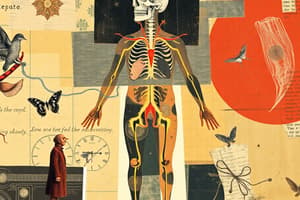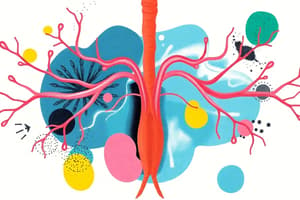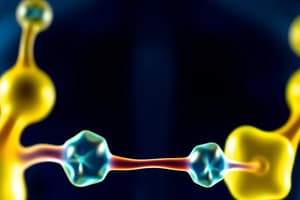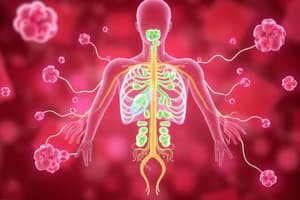Podcast
Questions and Answers
Which hormone is primarily responsible for setting the basal metabolic rate (BMR) and promoting the maturation of the brain?
Which hormone is primarily responsible for setting the basal metabolic rate (BMR) and promoting the maturation of the brain?
- Epinephrine
- Thyroxine (T4) (correct)
- Cortisol
- Parathyroid hormone (PTH)
Which hormone is secreted by the adrenal medulla and is associated with the 'fight or flight' response?
Which hormone is secreted by the adrenal medulla and is associated with the 'fight or flight' response?
- Thyroxine (T4)
- Testosterone
- Aldosterone
- Norepinephrine (correct)
What is the main function of parathyroid hormone (PTH)?
What is the main function of parathyroid hormone (PTH)?
- Stimulating the immune response
- Controlling blood calcium levels (correct)
- Promoting kidney function
- Regulating blood glucose levels
Which of the following hormones is secreted by the ovaries?
Which of the following hormones is secreted by the ovaries?
What effect does melatonin have on puberty in humans?
What effect does melatonin have on puberty in humans?
What is the primary mode of communication for the endocrine system?
What is the primary mode of communication for the endocrine system?
How does the response time of the endocrine system generally compare to that of the nervous system?
How does the response time of the endocrine system generally compare to that of the nervous system?
Which gland is primarily responsible for releasing hormones that affect metabolism?
Which gland is primarily responsible for releasing hormones that affect metabolism?
What distinguishes hydrophilic hormones from hydrophobic hormones in terms of their action mechanism?
What distinguishes hydrophilic hormones from hydrophobic hormones in terms of their action mechanism?
What is a primary characteristic of endocrine glands?
What is a primary characteristic of endocrine glands?
Which of the following accurately describes the effect duration of hormones released by the endocrine system?
Which of the following accurately describes the effect duration of hormones released by the endocrine system?
Which type of hormone typically interacts with intracellular receptors?
Which type of hormone typically interacts with intracellular receptors?
What role do receptors play in the action of hormones?
What role do receptors play in the action of hormones?
Which type of hormone is derived from cholesterol?
Which type of hormone is derived from cholesterol?
What defines a glycoprotein hormone?
What defines a glycoprotein hormone?
Which of the following hormones is NOT categorized as a polypeptide?
Which of the following hormones is NOT categorized as a polypeptide?
Steroid hormones primarily interact with which part of the target cell?
Steroid hormones primarily interact with which part of the target cell?
Which of these hormones utilizes a second messenger system for its action?
Which of these hormones utilizes a second messenger system for its action?
Which hormone is produced by the adrenal medulla?
Which hormone is produced by the adrenal medulla?
What is the primary action of a second messenger in hormone signaling?
What is the primary action of a second messenger in hormone signaling?
Which hormone binds to nuclear receptors?
Which hormone binds to nuclear receptors?
Which mechanism is involved in the phospholipase C-Ca++ signaling pathway?
Which mechanism is involved in the phospholipase C-Ca++ signaling pathway?
Which hormones are classified as amine hormones?
Which hormones are classified as amine hormones?
What role does Ca++ play in cellular signaling?
What role does Ca++ play in cellular signaling?
What happens when insulin binds to its receptor?
What happens when insulin binds to its receptor?
Which hormone primarily uses cAMP as its second messenger?
Which hormone primarily uses cAMP as its second messenger?
Which correctly describes the action of inositol triphosphate (IP3)?
Which correctly describes the action of inositol triphosphate (IP3)?
What could be a consequence of abnormally high hormone concentrations?
What could be a consequence of abnormally high hormone concentrations?
Where does ADH primarily increase water absorption in the kidneys?
Where does ADH primarily increase water absorption in the kidneys?
What is the primary function of oxytocin?
What is the primary function of oxytocin?
What effect does growth hormone have on cells?
What effect does growth hormone have on cells?
What is the result of receptor desensitization?
What is the result of receptor desensitization?
What is the role of thyroid-stimulating hormone (TSH)?
What is the role of thyroid-stimulating hormone (TSH)?
What hormone stimulates the adrenal cortex to secrete cortisol?
What hormone stimulates the adrenal cortex to secrete cortisol?
What condition results from hypersecretion of GH during childhood?
What condition results from hypersecretion of GH during childhood?
Which hormone is primarily involved in stimulating milk production by mammary glands?
Which hormone is primarily involved in stimulating milk production by mammary glands?
What effect does the hypothalamus have on the anterior pituitary gland?
What effect does the hypothalamus have on the anterior pituitary gland?
What hormone's abnormal levels cause symptoms of hypothyroidism?
What hormone's abnormal levels cause symptoms of hypothyroidism?
In which condition is high TSH activity observed due to iodine deficiency?
In which condition is high TSH activity observed due to iodine deficiency?
Which hormone plays a crucial role in sperm production?
Which hormone plays a crucial role in sperm production?
What condition is characterized by facial and skeletal growth due to excess GH in adulthood?
What condition is characterized by facial and skeletal growth due to excess GH in adulthood?
What is a common symptom of hyperthyroidism?
What is a common symptom of hyperthyroidism?
In females, what effect does luteinizing hormone have?
In females, what effect does luteinizing hormone have?
Flashcards
Nervous System Response Time
Nervous System Response Time
The nervous system responds quickly to stimuli, often within milliseconds.
Endocrine System Response Time
Endocrine System Response Time
The endocrine system responds more slowly, taking minutes to hours to produce an effect.
Nervous System Signal Transmission
Nervous System Signal Transmission
The nervous system uses electrical impulses and neurotransmitters to signal between cells.
Endocrine System Signal Transmission
Endocrine System Signal Transmission
Signup and view all the flashcards
Nervous System Target Cells
Nervous System Target Cells
Signup and view all the flashcards
Endocrine System Target Cells
Endocrine System Target Cells
Signup and view all the flashcards
Peptide Hormones: Release
Peptide Hormones: Release
Signup and view all the flashcards
Steroid Hormones: Release
Steroid Hormones: Release
Signup and view all the flashcards
Thyroxine (T4)
Thyroxine (T4)
Signup and view all the flashcards
Parathyroid Hormone (PTH)
Parathyroid Hormone (PTH)
Signup and view all the flashcards
Epinephrine & Norepinephrine
Epinephrine & Norepinephrine
Signup and view all the flashcards
Cortisol
Cortisol
Signup and view all the flashcards
Melatonin
Melatonin
Signup and view all the flashcards
Amine Hormones
Amine Hormones
Signup and view all the flashcards
Examples of Amine Hormones
Examples of Amine Hormones
Signup and view all the flashcards
Polypeptide/Protein Hormones
Polypeptide/Protein Hormones
Signup and view all the flashcards
Glycoprotein Hormones
Glycoprotein Hormones
Signup and view all the flashcards
Steroid Hormones
Steroid Hormones
Signup and view all the flashcards
Examples of Steroid Hormones
Examples of Steroid Hormones
Signup and view all the flashcards
Target Cells
Target Cells
Signup and view all the flashcards
Mechanism of Steroid Hormone Action
Mechanism of Steroid Hormone Action
Signup and view all the flashcards
Genomic Action
Genomic Action
Signup and view all the flashcards
Second Messengers
Second Messengers
Signup and view all the flashcards
ACTH
ACTH
Signup and view all the flashcards
Pituitary dwarfism
Pituitary dwarfism
Signup and view all the flashcards
Gigantism
Gigantism
Signup and view all the flashcards
Acromegaly
Acromegaly
Signup and view all the flashcards
FSH (Follicle Stimulating Hormone)
FSH (Follicle Stimulating Hormone)
Signup and view all the flashcards
LH (Luteinizing Hormone)
LH (Luteinizing Hormone)
Signup and view all the flashcards
Prolactin (PRL)
Prolactin (PRL)
Signup and view all the flashcards
Hypothalamic-Pituitary Portal System
Hypothalamic-Pituitary Portal System
Signup and view all the flashcards
Thyroid hormones (T4 and T3)
Thyroid hormones (T4 and T3)
Signup and view all the flashcards
Hypothyroidism
Hypothyroidism
Signup and view all the flashcards
IP3's Role
IP3's Role
Signup and view all the flashcards
Calcium's Role in Signaling
Calcium's Role in Signaling
Signup and view all the flashcards
Tyrosine Kinase System
Tyrosine Kinase System
Signup and view all the flashcards
Insulin's Action
Insulin's Action
Signup and view all the flashcards
What Hormone Uses cAMP as Second Messenger?
What Hormone Uses cAMP as Second Messenger?
Signup and view all the flashcards
IP3's Function
IP3's Function
Signup and view all the flashcards
Hormonal Responses and Concentration
Hormonal Responses and Concentration
Signup and view all the flashcards
Posterior Pituitary Hormones
Posterior Pituitary Hormones
Signup and view all the flashcards
Oxytocin's Functions
Oxytocin's Functions
Signup and view all the flashcards
Anterior Pituitary Hormones
Anterior Pituitary Hormones
Signup and view all the flashcards
Study Notes
Thanksgiving Feast
- Hosted by Associated Students
- November 21, 3:00 PM - 6:00 PM
- Mesa Commons, MC-211
- Free food, games, entertainment, opportunity drawings
- Friendly atmosphere
- Donations accepted for The Stand (dry/canned foods, hygiene supplies)
- Contact: Courtney Lee, [email protected], or 619-388-2699
- Disability accommodations requests due 5 days prior at 619-388-2699
Today's Learning Objectives
- Describe chemical classification of hormones
- Compare and contrast mechanisms of action of hydrophilic vs. hydrophobic hormones
- Compare and contrast different types of second messenger systems
- Describe hormonal actions and interactions from: pituitary gland, thyroid gland, adrenal gland, islets of Langerhans
- Describe action of miscellaneous endocrine glands and hormones
Hormones: What are some hormones that you can think of?
- The text provides a cartoon image and caption discussing hormones
Comparison of Nervous & Endocrine
- Nervous System:
- Quick response (milliseconds)
- Short duration effect
- Works via electrical impulses and direct release of chemicals (neurotransmitters)
- Affects specific cells (neurons, muscle, gland) resulting in specific responses (e.g., muscle contraction)
- Endocrine System:
- Slower response (minutes to hours)
- Potentially long duration effect (hours to days)
- Works via chemical signals (hormones) released into blood capillaries
- Affects multiple cells throughout the body with specific hormone receptors ("target cells")
- Results in changes in metabolic activities of cells (e.g., protein synthesis, ATP production)
Endocrine Glands
- Ductless glands that secrete hormones
- Chemicals secreted into blood to communicate (slow)
- Each hormone binds to a specific receptor on a target cell
- Affects the metabolism of target cells
Check in with a neighbor
- Table comparing peptide, steroid, and amino acid-derived hormones (synthesis, storage, release from parent cell, transport in blood, half-life, receptor location, response to receptor-ligand binding, general target response, examples)
Chemical Classification of Hormones
- Amine: Derived from tyrosine or tryptophan
- Examples: norepinephrine, epinephrine, thyroxine, triiodothyronine
- Hydrophobic
- Polypeptide/protein: Chains of amino acids
- Examples: ADH, growth hormone, insulin, glucagon
- Glycoproteins: Carbohydrate attached to protein
- Examples: LH, FSH, TSH
- Steroids: Lipids derived from cholesterol
- Examples: testosterone, estrogen, progesterone, cortisol
- Hydrophobic
Hormone Function
- Hormones affect only certain tissues/organs (target cells/organs)
- Target cells must have specific protein receptors
- Hormone binding alters cellular activity
Steroid Hormone: Mechanism of Action
- Steroid hormone passes through plasma membrane (non-polar)
- Binds to receptor in the cytoplasm forming a complex
- Complex moves into the nucleus
Steroid Hormone Receptor
- 2 Complexes (dimerize)
- Bind to hormone response element on DNA
- Synthesis of RNA (called genomic action) takes at least 30 minutes
Review Question (Which of these hormones have nuclear receptors?)
- Possible answers: adrenal cortex, gonads, both A & B
Hormones That Use 2nd Messengers
- Water-soluble hormones cannot pass through plasma membrane, so use cell surface receptors
- Actions are mediated by 2nd messengers
- Hormone is the 1st messenger
- 2nd messenger carries signal from receptor to inside of cell
Three Types of 2nd Messenger Systems
- Adenylate cyclase – cAMP system
- Phospholipase C – Ca++ system
- Tyrosine Kinase system
Adenylate Cyclase-cAMP
- Hormone binds to receptor, G-proteins dissociate
- Activates adenylate cyclase (ATP)
- Converts ATP to cAMP (2nd messenger)
- cAMP activates protein kinase
- Protein kinase phosphorylates enzymes
- Examples: epinephrine, norepinephrine, glucagon, FSH
Phospholipase C- Ca++ system
- Hormone binds to receptor
- G proteins signal phospholipase C (PLC)
- PLC forms inositol triphosphate (IP3)
- IP3 causes Ca++ channel to open in ER
- Ca++ is a 2nd messenger
- Ca++ binds to calmodulin
- Activates enzymes to bring about desired responses
- Examples: epinephrine and α-receptors
Tyrosine Kinase System: for insulin
- Receptor itself is an enzyme (tyrosine kinase)
- Insulin binds to 2 units of receptor
- Receptors dimerize (come together)
- Tyrosine kinase phosphorylates itself > activated
- Glucose uptake
Glucose Uptake by Insulin
Review Question (Which of these hormones uses cAMP as a second messenger?)
- Possible answer: Epinephrine
Review Question (Which of these correctly describes the role of inositol triphosphate (IP3)?
- Possible answer: It stimulates the release of Ca++ from the endoplasmic reticulum
Hormonal Actions and Interactions
Hormone Levels and Tissue Responses
- Effects of hormones depend on concentration
- Abnormally high concentration can have bad side effects (e.g., male athletes, anabolic steroids)
- Desensitization/downregulation of receptors decreases hormone effect on target
The Pituitary Gland
Posterior Pituitary Gland
- Stores and releases 2 hormones made in the hypothalamus
- ADH: increases H2O absorption in kidneys
- Oxytocin: Uterus contraction during labor, milk let-down in lactating women
Clinical Example: Oxytocin
- Synthetic injections (pitocin) are given to pregnant women to induce labor during prolonged pregnancy or fetal membrane rupture leading to infection
- Preeclampsia
- Used post-delivery to reduce uterus size, preventing hemorrhage
Anterior Pituitary
- Growth hormone (GH): Promotes growth of cartilage and bone, protein synthesis, amino acid movement into cells
- Thyroid-stimulating hormone (TSH): Stimulates thyroid to produce and secrete T4 and T3
- Adrenocorticotropic hormone (ACTH): Stimulates adrenal cortex to secrete cortisol and aldosterone
GH Disorders
- Pituitary dwarfism (hyposecretion of GH during childhood)
- Gigantism (hypersecretion of GH during childhood)
- Height over ~8'
- Puberty often delayed
- Acromegaly (hypersecretion of GH during adulthood)
Anterior Pituitary (cont.)
- Follicle-stimulating hormone (FSH): Stimulates growth of ovarian follicle, and sperm production
- Luteinizing hormone (LH): Causes ovulation, and secretion of testosterone in testes
- Prolactin (PRL): Stimulates milk production by mammary glands
Hypothalamic control of anterior pituitary via Hypothalamic-Pituitary Portal System
- Hypothalamus controls anterior pituitary secretion
- Receives input from higher brain centers (emotional states, psychological stress, circadian rhythms, menstrual cycle, adrenal hormones)
Review Question (Compare and contrast the control that the hypothalamus has over anterior and posterior pituitary glands)
Thyroid Hormones
- Made in thyroid follicles using iodine and tyrosine amino acids
- T4 (thyroxine) and T3 (triiodothyronine)
- Set BMR, protein synthesis
- Needed for growth and development
Clinical Examples involving TH
- Hypothyroidism (low T4 & T3 levels): low BMR, weight gain, lethargy, cold intolerance
- Endemic Goiter (iodine deficiency): High TSH (low T3 & T4), thyroid growth
- Cretinism (fetal development hypothyroidism): severe mental retardation
Endemic Goiter (iodine deficiency)
Hyperthyroidism
- High thyroxine (T4) secretion
- High BMR, weight loss, nervousness, irritability, intolerance to heat
- Graves disease: autoimmune disease
- Antibodies have TSH-like effects
- Not inhibited by negative feedback
- Excess thyroid stimulation > excess T4
- Exopthalmos (bulging eyes)
Review Question (The secretion of which of these hormones would be increased in a person with endemic goiter?)
- Possible answer: TSH
Review Question (The hormone primarily responsible for setting the BMR & for promoting the maturation of the brain is...)
- Possible answer: Thyroxine (T4)
Parathyroid Glands
- Secrete parathyroid hormone (PTH)
- Most important hormone for controlling blood Ca2+ levels
Adrenal Medulla: Amine hormones
- Epinephrine and norepinephrine
- Controlled by sympathetic nervous system
- Activated during "fight or flight" response
Adrenal Cortex: Steroid hormones
- Mineralocorticoids (aldosterone): Salt and H2O absorption in kidneys
- Glucocorticoids (cortisol): Inhibits glucose uptake, inhibits inflammation, suppresses immune system, weak androgens (supplements sex steroids of gonads)
Melatonin
- Secretion regulated by suprachiasmatic nucleus (SCN) of hypothalamus (circadian rhythms)
- Reset by daily environmental light/dark changes
- Synchronizes physiology with sleep/wake cycle and seasons
- Secreted at night and inhibited by light
- Antigonadotropic effects in many animals (in humans, delays puberty)
Gonads & Placenta
- Ovaries: estrogen and progesterone
- Testes: testosterone
- Placenta: estrogen, progesterone, hCG
- Discussed in reproductive system
Studying That Suits You
Use AI to generate personalized quizzes and flashcards to suit your learning preferences.




